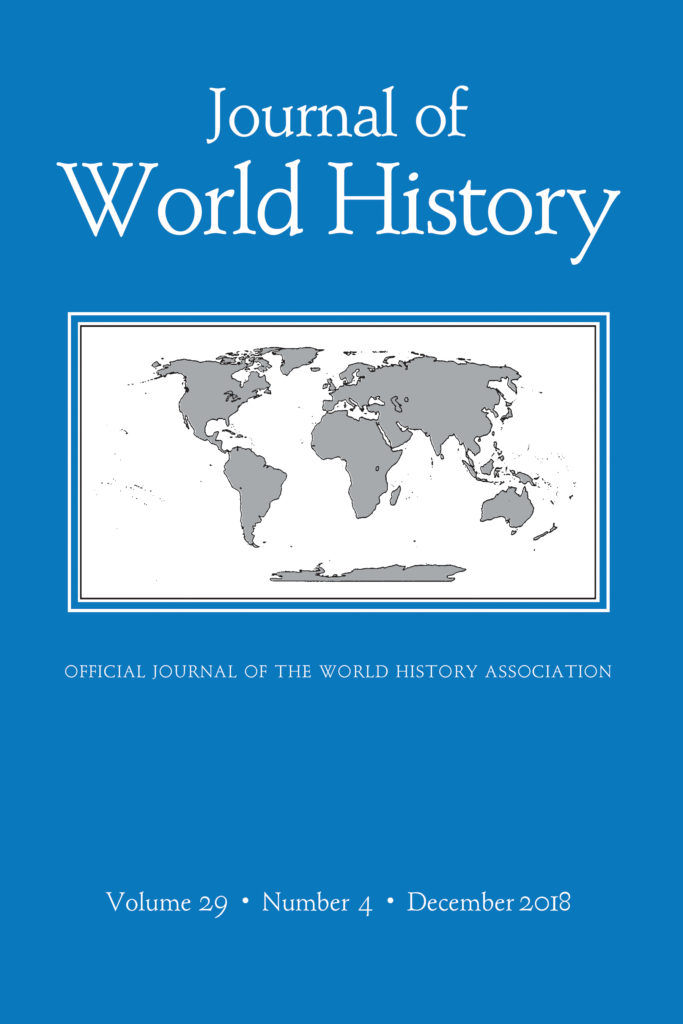This issue of the Journal of World History includes the following scholarly articles:
Daud Shah and Dar ul-Islam: Transnational Elements of Socio-religious Reforms among Muslims in the Madras Presidency*
By Sundara Vadlamudi
Colonial British India witnessed a large increase in the formation of socio-religious reform movements during the nineteenth and twentieth centuries. The major religious groups in British India sought to address the criticisms of Christian missionaries, enact responses to changing social and economic conditions under British imperialism, and attempt to resolve problems in their communities. This article examines the work of Daud Shah, an advocate for socio-religious reforms among Tamil-speaking Muslims in the Madras Presidency and the Bay of Bengal littoral. Existing research on Shah has examined his work within the context of social and political developments within the colonial Madras Presidency. This article argues that a proper assessment of Shah’s contribution to socio-religious reform can only be made by including the transnational aspects of his reform efforts, including sources of his religious knowledge and the impact of his actions on the diasporic community of Tamil Muslims in the Indian Ocean.
Divide to Unite: Ou Jujia, New Guangdong, and Provincial Consciousness in 1900s China
By Ying-Kit Chan
Under the “revolution paradigm” of existing Chinese historiography, Han Chinese intellectuals of the late nineteenth and early twentieth centuries are viewed as either supporting or resisting monarchical rule in Qing China (1644–1912). This article examines the implications of Guangdong intellectual Ou Jujia’s (1870–1912) magnum opus, New Guangdong, for late Qing politics. New Guangdong called for Guangdong’s independence from the Qing so that it could later reunite with other provinces as a federated China. Although Ou Jujia’s attempts to launch an independence movement had remained marginal to the reformist and revolutionary visions of governance and national unity, he embedded provincial consciousness in the modern, Western-inspired language of federalism. By suggesting that Guangdong could become a unique model province of a reformed China, Ou Jujia defined the “province” as the basic unit of Chinese federalism and made it central to discussions of China’s future in the 1900s.
Mysterious Ships, Troublesome Loans, and Rumors of War: The Tokugawa Arrest of Suetsugu Heizō Shigetomo
By Timothy Romans
By the late seventeenth century, independent maritime organizations such as the Suetsugu could not survive the changing dynamics of an East Asian maritime world that became increasingly polarized by Tokugawa Japan and the Qing Empire. Through their alliance to the Zheng family, the Suetsugu sought to maintain an independent network of merchants, smugglers, and pirates. Suetsugu connections to the Zheng family expanded Tokugawa commercial relations to ports throughout Asia. However, when the Qing conquered China in the mid-seventeenth century, Tokugawa Japan came to increasingly fear war with this emerging empire. The activities of the Zheng family and their allies, the Suetsugu, nearly brought East Asia to the brink of conflict in 1676. Instead of risking war with the Qing Empire, the Tokugawa chose to arrest and banish Suetsugu Heizō IV to maintain the stability of their regime within a multipolar international framework that was East Asia’s new reality.
Taking Children, Ruling Colonies: Child Removal and Colonial Subjugation in Australia, Canada, French Indochina, and the United States, 1870–1950s
By Christina Firpo and Margaret Jacobs
In the late nineteenth and early twentieth centuries, the French colonial government in Indochina and the settler colonial nations of the United States, Australia, and Canada all engaged in the systematic removal of Indigenous and/or mixed-race children from their families. All four governments placed the children in institutions that were meant to sever ties to their home communities, re-educate and assimilate them, and then slot them into particular roles in the colonial social order. By comparing child removal programs in these four colonial contexts, we contend that diverse colonial administrations used child removal as a key strategy of governance to address various political and demographic problems. In the settler colonial nations, child removal functioned primarily as a means of eliminating Indigenous identities, cultures, and land claims. In Indochina, the French carried out child removal to create a French colonial elite that would reside permanently in the colony. This comparative approach reveals significant insight into colonial practices, including authorities’ preoccupation with intimate family lives and children’s upbringing, how officials and reformers turned to benevolent discourses to describe violent and coercive practices, how Indigenous women suffered from particular vilification, and how authorities removed Indigenous and/or mixed-race children to manage racial dynamics. The article particularly demonstrates the value of collaborative and comparative scholarship.
Plus book reviews.





